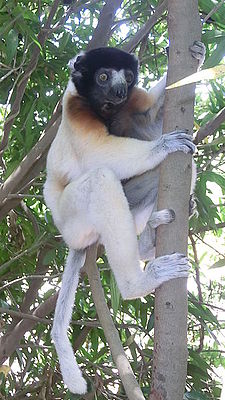Crown Sifaka
| Crown Sifaka | ||||||||||||
|---|---|---|---|---|---|---|---|---|---|---|---|---|

Crown Sifaka ( Propithecus coronatus ) |
||||||||||||
| Systematics | ||||||||||||
|
||||||||||||
| Scientific name | ||||||||||||
| Propithecus coronatus | ||||||||||||
| Milne Edwards , 1871 |
The crown sifaka ( Propithecus coronatus ) is a species of primate from the family of the Indri-like within the lemurs . It was formerly considered a subspecies of the larval sifaka .
features
Crowned Sifakas reach a head body length of 40 to 46 centimeters, the tail length is 48 to 57 centimeters. The weight varies between 3.5 and 4.3 kilograms, they are one of the smaller sifaka species . Their fur is predominantly white, the head, neck and throat are dark brown or black. The chest, shoulders, and upper arms can sometimes be slightly yellowish-brown in color. The face is hairless and gray in color, the ears are whitish. As with all Sifakas, the hind legs are significantly longer than the front legs.
distribution and habitat
Like all lemurs, these primates only occur in Madagascar . They inhabit a small area on the west coast, which lies between the Mahavavy and Betsiboka rivers and extends somewhat inland. Their habitat are dry deciduous forests, they can be found up to 700 meters above sea level.
Way of life
Crowned Sifakas are diurnal tree dwellers that climb and jump vertically in the branches. They live in groups of two to eight animals made up of one or more males, one or more females and their offspring. They are territorial animals, their territories are very small with 1.2 to 1.5 hectares. In addition, they are mostly in a small core area of only 0.3 hectares in size.
In the dry season, eating takes up around 30 to 40% of the day, the rest is spent resting or used for interacting with group members. During this time they will eat buds, unripe fruits and leaves. The food composition in the rainy season is not known.
Danger
The main threat to the Crowned Sifakas is the destruction of their habitat from deforestation and charcoal production . The IUCN estimates that the total population is (three generations) declined over the past 30 years by more than 50%, and lists the species as "critically endangered" ( endangered ).
In Europe, the species is kept in France, Great Britain and the Netherlands. The only German owner has been the Heidelberg Zoo since 2017.
literature
- Nick Garbutt: Mammals of Madagascar. A Complete Guide. Yale University Press, New Haven CT et al. 2007, ISBN 978-0-300-12550-4 .
- Thomas Geissmann : Comparative Primatology. Springer-Verlag, Berlin et al. 2002, ISBN 3-540-43645-6 .
- Russell A. Mittermeier , Jörg U. Ganzhorn, William R. Konstant, Kenneth Glander, Ian Tattersall , Colin P. Groves , Anthony B. Rylands, Andreas Hapke, Jonah Ratsimbazafy, Mireya I. Mayor, Edward Louis jr, Yves Rumpler, Christoph Schwitzer, Rodin Rasoloarison: Lemur Diversity in Madagascar. In: International Journal of Primatology. 29, 2008, ISSN 0164-0291 , pp. 1607-1656.
supporting documents
Web links
- Propithecus coronatus onthe IUCN Red List of Threatened Species . Retrieved April 26, 2009.

